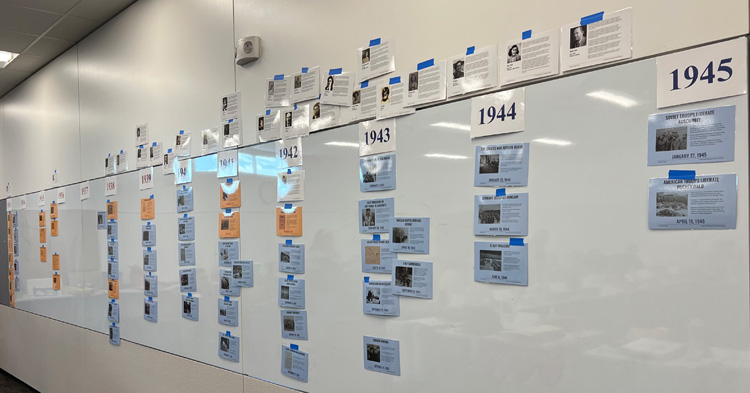
Note about the content on this page:
In addition to containing original content, the Gellert Center for Education area of our site makes heavy use of links to vetted online material that further explains or enhances the information on these pages. All of these links appear in red like this link to the main page of our web site. We encourage you to follow these links – they will open in new tabs or windows (depending on your browser settings) so you will not lose access to the page you are viewing here.
Introduction to the Holocaust
The Holocaust was the systematic, state-sponsored persecution and murder of six million European Jews by the Nazi German regime and its allies and collaborators. The Holocaust was an evolving process that took place throughout Europe between 1933 and 1945. (USHMM)
Fundamentals of Teaching the Holocaust
Teaching about the Holocaust can inspire students to think critically about the past and their own roles and responsibilities today. Use the resources below to help develop your approach and to find lesson plans to use in your classroom.
Guidelines for Teaching About the Holocaust
Teaching Holocaust history requires a high level of sensitivity and keen awareness of the complexity of the subject matter. The following guidelines reflect approaches appropriate for effective teaching in general and are particularly relevant to Holocaust education.
- Define the term “Holocaust.”
- The Holocaust was not inevitable.
- Avoid simple answers to complex questions.
- Strive for precision of language.
- Strive to balance the perspectives that inform your study of the Holocaust.
- Avoid comparisons of pain.
- Avoid romanticizing history.
- Contextualize the history.
- Translate statistics into people.
- Make responsible methodological choices.
Age Appropriateness – USHMM
Teaching the Holocaust to Grade Six and Above
Students in grades six and above demonstrate the ability to empathize with individual eyewitness accounts and to attempt to understand the complexities of Holocaust history, including the scope and scale of the events. While elementary age students are able to empathize with individual accounts, they often have difficulty placing them in a larger historical context.
Such developmental differences have traditionally shaped social studies curricula throughout the country. In most states, students are not introduced to European history and geography—the context of the Holocaust—before middle school. Elementary school can be an ideal place to begin discussing the value of diversity and the danger of bias and prejudice. These critical themes can be addressed through local and national historical events and can be reinforced during later study of the Holocaust.
One-Day Lesson – Introduction to the Holocaust
This one-day lesson provides an introduction to the Holocaust by defining the term and highlighting the story of one Holocaust survivor, Gerda Weissmann.
Grade level: Adaptable for grades 7–12
Subject: Multidisciplinary
Time required: Approximately 60 minutes
Lesson: Holocaust Timeline Activity
This lesson is structured around a multi-layered wall timeline that encourages critical thinking about the relationship between Nazi policy, World War II, historical events, and individual experiences during the Holocaust.
Grade level: Adaptable for grades 7–12
Subject: Multidisciplinary
Time required: This activity is highly adaptable and can be completed in 60 minutes or multiple class sessions, used as a point of reference throughout an entire unity of study, or have thematic extension activities added.

Thank you to our partners in this program:
To help us improve the Gellert Center for Education section of our web site, please complete the form below and share your information with us. By providing this information, we will be able to learn more about who is using this site, to send you emails about updates to our content and to ask for your feedback on our materials and programs. NOTE: We will never share, rent or sell your information to any third part individual, company or organization.



